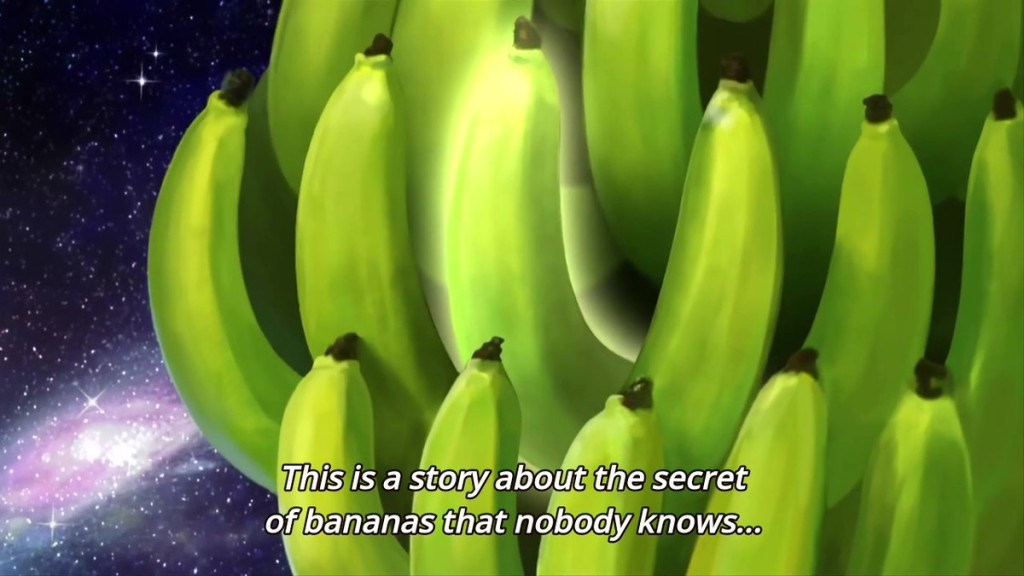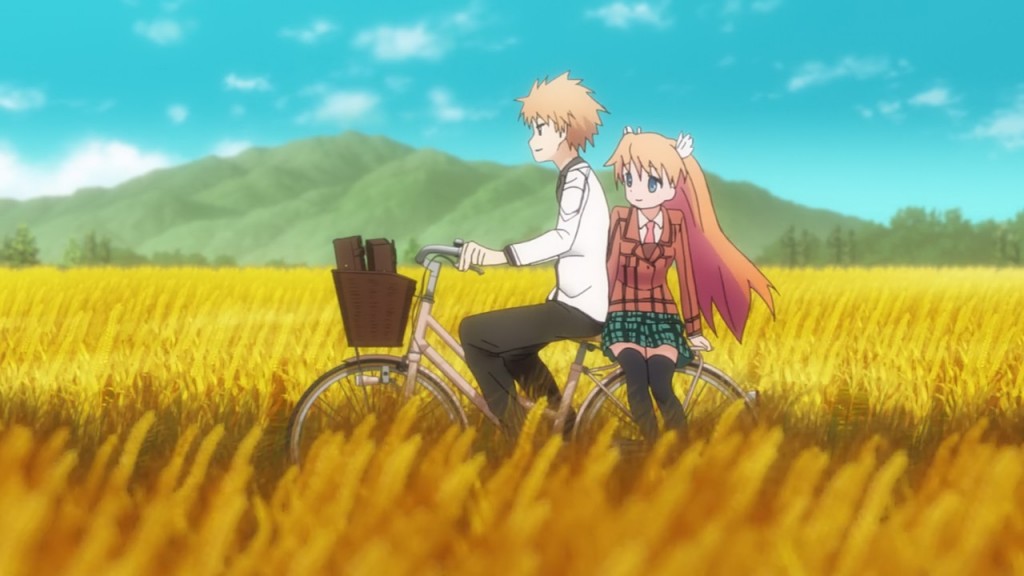07.04
[For this Clusterfuck, I’m planning on cutting them into parts because I think readers would find 10 2000-word articles easier to stomach than 1 20000-word article. So when the word counts go over 2000 words, that will be the time to go to part 2 and so on.]
Bananya
– Kirk Cameron and Ray Comfort
D. Gray-Man Hallow
What is it with long-defunct anime adaptions getting new seasons all of a sudden? Yes, D. Gray-Man has returned after an eight-year reprieve because apparently not everyone gave up on the series after the manga’s years-long hiatus and nonsensical plot developments. If Food Wars! fans felt their second season premiere was too fast, D. Gray-Man Hallow has the opposite problem. It’s painfully slow. The entire episode is spent expositing one fact – that Allen is the vessel for the Fourteenth’s resurrection – and nothing else, stretched out with unfunny comedy, unnecessary flashbacks, and extraneous scenes with other characters who will be irrelevant in the grand scheme of the arc this season is adapting. Maybe if the episode looked or flowed nicely that stuff wouldn’t feel as tedious, but the animation is bare-bones, even during the fight scene that begins the episode, and the dark color scheme is drab, dull, and unpleasing to the eye. The only point of interest in the entire premiere is the supposed murder of Allen’s mentor, Cross Marien, at the end of the episode, but that hook is pulled early by the next episode preview which reminds you that they’re still planning to cover the completely pointless Phantom Thief arc because the Alma Karma stuff isn’t enough to sustain a whole cour on it’s own. You know, they should’ve kept that whole zombie mini-arc and ran that as the premiere episode instead. Sure, it’s random and time-wasting comedy filler, but it would’ve still been more entertaining than a whole episode of nothing.
If you like D. Gray-Man, then Hallow is an unimpressive but inoffensive return for the series that cleanly picks up where the previous anime left off. If you don’t care about D. Gray-Man, however, then there’s no value to watching this show at all, since it’s exceedingly boring and makes no sense without having seen the previous 100+ episodes. The best I can say about Hallow is that at least it’s storytelling makes sense, unlike the current run of the manga. The Alma Karma arc is also probably the last half-way decent part of the series before it becomes unfathomably incomprehensible, so there’s that. Enjoy it while it lasts. – LumRanmaYasha
The Heroic Legend of Arslan: Dust Storm Dance
I lost interest in the first season of Arslan early on. It was a slowly paced and unimpressively executed adaption of Hiromu Arakawa’s manga and Yoshiki Tanaka’s original novels, marred by some bad CGI and choppy animation. Not a bad show, by any means, but not one I felt compelled to continue watching, especially after hearsay about the show’s downturn in quality in the second half. So I came into this premiere with pretty low expectations, but I was thoroughly surprised. The show has really improved from the first season in terms of pacing and the choreography of it’s close-combat and large-scale battles. Crowd shots still copy and paste the same CGI models over again, but the show does a better job of hiding it through better framing of the camera and swooping, constantly moving camerawork. The momentum of the battle that opens this episode is enthralling, moving from one character and scuffle to the next with a breathless fluidity.
Even better, a lot happens in this episode. There are at least four separate plotlines that develop here, each bringing with it a dramatic change to the status quo of the series and setting up the core conflict of the season’s arc. The characters are very quickly re-established without much exposition or elaboration, and it’s pretty easy to get caught up to speed in what’s going on in the series even if you haven’t watched much of the previous season. With it’s unusually short episode length of eight episodes, this season should benefit from more concise storytelling, and with the visual embellishments displayed there’s a lot to look to like and look forward to here. Even if you haven’t watched or weren’t into the first season, the second season promises to be a smartly-written and self-contained medieval fantasy action story that should prove worthwhile to fans of this sort of genre entertainment. – LumRanmaYasha
Rewrite
The mid-2000s! A horrible time when men and women thought Air and Clannad were good shows, and you just stood in a corner wondering what the hell everyone was talking about. A paper-thin tearjerker with waifus out the vazoom were the dish of the day, with episode after episode of brain-damaged, terminally ill girls needing their dry, sarcastic harem protagonist to fix them and make things all better. Remember Kotomi. Remember Cud. And oh sweet mother of Mary, remember Ayu. All Valkyries of the Nakige Valhalla, making those tears drop onto your already stained keyboard. Thankfully, we know better. We watch episode after episode of brain-damaged, terminally ill girls needing their henpecked abuse victim of a protagonist to fix them and make things better. Much more progressive for today’s anime taste buds.
But Rewrite takes us back to that hellish time, with fluffy schoolgirl uniforms, red strings of fate, and Sasuke haircuts. All in one double-length episode too just to commemorate the lunacy. Throughout those forty-and-some minutes were girls stuck in trees, girls sitting at trees, girls making bee noises while nearby trees. Just girl after girl, like a beauty competition for those too young for Toddlers & Tiaras, are presented to you with dialogue observing how they’re the main character’s friends instead of using body language or word choice to indicate that to begin with. I grow weary and impatient as our dear Kotaro, except I don’t sleep in a hoodie thank you very much (seriously, why did he sleep in a hoodie, that’s uncomfortable). I see fury, I see sadness, I see France, I see blue-striped underpants. Ooh, a Key show makes a vicious beast, even one not written by the Maker known as Maeda. At last, we face another season of confusion, where visual novel readers tell us this will all make sense in due time yet that time keeps growing like worms from pus. Pray to your Gods, for I swear Rewrite will irreparably taint your MAL catalogs!
Oh and another thing, the director for this show? He did all the Grisaia series too. Happy shitting. – Bloody Marquis
Sweetness and Lightning
You know, for as many “single guy raising a little girl” stories there are in anime and manga, few are actually about an actual dad raising his daughter. In fact, there’s only two that come to mind – the modern manga classic Yotsuba&! and this series, Sweetness and Lightning. Even moreso than Yotsuba&!’s titular protagonist, Tsumugi feels like a believable little girl in the way she talks and expresses herself, and her infectious enthusiasm and excitement about even the most simple of things is too adorable not to find endearing. She is lovingly animated, bouncing across the screen with such liveliness, each movement she makes imbued with the expressive character of a child. Even if you hate kids, it’s hard not to be charmed by the innocent vivacity of this little girl.
But adorable as Tsumugi may be, the heart of the series lies with her single father, Kohei, and his attempts to do right by her as a single father. The show begins with the day of father and daughter beginning in the morning, and this sequence very quickly establishes they have a very loving relationship and he’s a considerate and attentive father. But we also soon learn that it hasn’t been long since his wife passed away, and in a heartbreaking moment, we see his daughter still doesn’t really understand that her mother won’t ever be coming back. It’s easy to root for him as he runs to a nearby restaurant to try and give his daughter a good meal like her mother used to make, and get as teary-eyed as him when he sees how much his daughter enjoys her fresh-cooked rice. Yeah, this is a series that’ll get even the most cynical of curmudgeons in the feels, and is as unapologetically optimistic and positive in it’s outlook as little Tsumugi herself. Which, in an era of increasingly cynical, moody, or grimdark anime, is rather refreshing in it’s own way.
If I had to guess, the title Sweetness and Lightning refers to a couple of things; the dynamic personality of little Tsumugi herself, the experiences of Kohei raising her, and the emotions of the audience watching it. There will be rough times, but rewarding times as well, both heart-warming and tear-jerking. It has one of the stronger emotional hooks for this kind of series, with an endearing central relationship and protagonist that you’ll want to follow even if the show is mostly about feel-good slice-of-life shenanigans. Helps that the show looks and is animated beautifully to boot. Unless you’re burned out on this sub-genre, Sweetness and Lightning is wholly recommended as one of the standout shows of the season. Unless it somehow fucks up and turns into Usagi Drop mid-way through, but that probably won’t happen. Probably. – LumRanmaYasha
Tales of Zestiria the X
My only prior experience with the Tales series is watching half of someone’s Let’s Play of Tales of Vesperia. What I got from that was a fun but a little meandering game. With that as my only basis for comparisons, Zestiria seems more… brown if you catch my drift? It’s brown and a little grimy in terms of scenery, and even when all the characters dress up in stupid colors, they all have some distinct brownish hue to their outfits. Yuri Lowell’s design looked brighter, and he was wearing mostly black. Maybe the other Tales games out-brown this. I’m not sure. If somebody could tell me how this compares to Xillia or Symphonia or Maradonia, that would be cool.
But that’s not to say this is poorly directed, because this has some of the most stunning animation I’ve seen in anime this year. You can tell someone was lining ufotable’s pockets to create this wonderful scenery and movement. It’s the kind of animation that you would shove into a Berserk fan’s face and watch as they cry because their show will never look as beautiful. Perhaps this will quickly run out and become a severe case of speed lines like what happened with Kabaneri, but right now I’m in awe. Another sign that ufotable’s several steps ahead of most other studios working right now.
Though maybe I was too focused on the animation to look at the subtitles, but I didn’t get much from the plot. I read this is actually an anime-only prologue and the real first episode will follow, so I could excuse it for that. But what did I get? Some professor discovers the Dust from The Golden Compass, and that leads to a little girl wearing collars bringing about destruction and mayhem? And from reading what other people said, the main girl who shows up in this episode doesn’t even do much in the game? Some of the elements sound interesting, but it still raises my concerns this will be another example of anime creators not knowing how to adapt a video game. And I’m wondering why this Tales installment is being adapted in particular. Is Zestiria especially popular in Japan to warrant an adaptation? But like I said, the animation’s neato. I’m sure sakugabooru’s already filled to the brim with clips of this show. – Bloody Marquis





